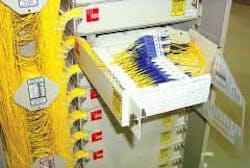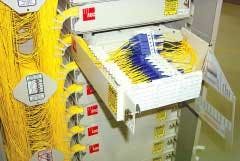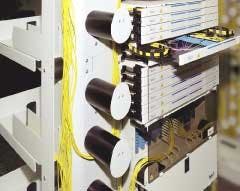GR-449 Issue 2 defines high-density frames
In 1995, Telcordia Technologies issued GR-449-CORE, "Generic Requirements for Fiber Distribution Frames." Thanks to the emergence of WDM and the development of smaller-diameter fibers, small-form-factor (SFF) connectors, moveable connectors and shelves, and fiber management software, that specification is no longer adequate. In an attempt to standardize next-generation high-density fiber distribution frames (FDFs), a new committee made up of carriers and equipment manufacturers is revisiting the standard—an effort that has taken more than a year.
"It's just a lot of information," admits Lloyd Lohf, engineering supervisor, optical products, at Telect (Liberty Lake, WA) and member of the Telcordia committee. "A lot of things have changed in the fiber world since 1995." The new issue, called Issue 2—driven "mostly by the RBOCs," he notes—defines standard density, footprint, frame-to-frame interfaces, and performance testing for the new-generation FDFs.
The FDF is the centralized point of access and maintenance for all fiber coming into and out of central offices (COs), controlled environmental vaults, communications huts, and even customer premises that serve fiber-optic networks. Ubiquitous throughout the network, FDFs are also the point at which carriers make crossconnections between their facility and their customers' facilities.
Because carriers often use certain types of FDFs for low-density applications and other types for high-density applications, the new GR-449 describes three types of FDFs—Generations I, II, and III. "Generations I and II are considered the low-density frames with typical termination capacities of 648 fibers per frame," explains Pat Thompson, senior product manager at ADC (Minneapolis), and a member of the Telcordia committee. "Generation III is considered the high-density frame with a termination capacity of 1,440 per frame or greater." These frames use standard SC and FC connectors, adds Thompson, rather than SFF or multifiber connectors.
Though the Generation III frame has a larger footprint than its lower-density cousins, it provides an increased number of terminations per square foot. Traditional Generation I and II frames have a footprint that is 26 inches wide and 12 or 15 inches deep, while the new frame is 30 inches wide and 24 inches deep.
Another critical aspect of Issue 2 is the frame-to-frame interface or how the patch cords are routed in the crossconnect environment. In Generation I and II FDFs, patch cords are routed through an upper or lower trough or a combination of both, which limits the capacity to roughly 8,000 fibers in a lineup, reports Thompson. Generation III FDFs feature a series of six rear troughs for routing between frames, which increases capacity to 23,000 terminations in a continuous-frame lineup.
"There's always been so much talk about fiber increase," says Tom Kampf, director of fiber solutions for the fiber connectivity group at ADC. "But I think here is some real evidence—much more than anecdotal—that the big carriers are taking the steps to ensure that they are able to manage the higher-count fiber lineups, not just now but for years down the road."
The committee also plans to set standards for performance testing of next-generation frames. Issue 1 called for bit-error-rate testing at OC-192 transmission rates, but Issue 2 will provide specifications for testing at the OC-768 or 40-Gbit/sec level. "That is a big thing carriers are looking at," contends Thompson. "They need to ensure that these systems will function at future transmission rates."While the GR-449-CORE Issue 2 addresses high density within the CO, it will not affect the outside plant—but such specifications could be on the horizon, contends Kampf. "We've always seen standardization of practices within offices of the large carriers, but we believe the trend is that we'll see more standardization within the outside plant as far as panel types selected, the interface style, the practice of using pre-terminated as opposed to field-terminated connectors. As fiber and the bandwidth grows and goes deeper into the network," he adds, "it's going to be more important to have those practices common throughout their network."
At press time, GR-449-CORE Issue 2 was slated for release by the end of March.


